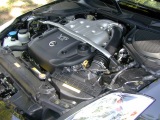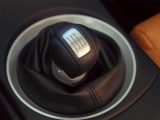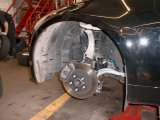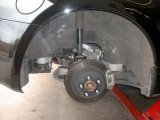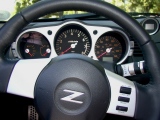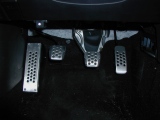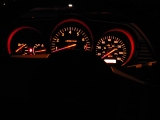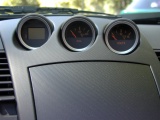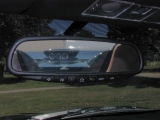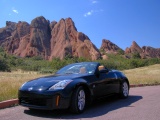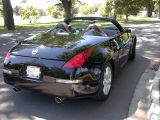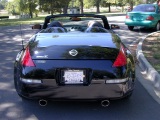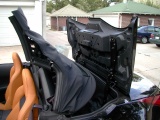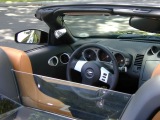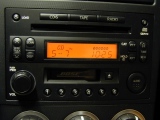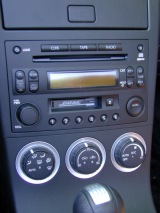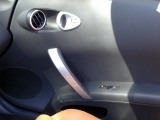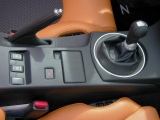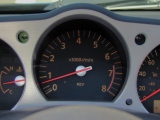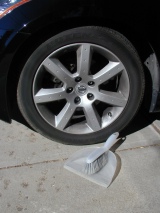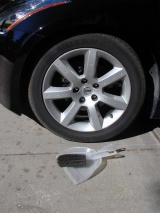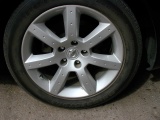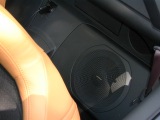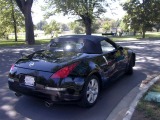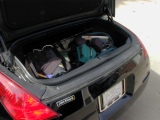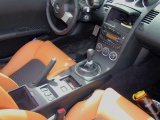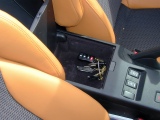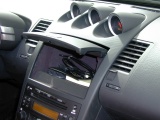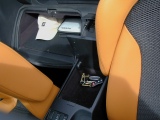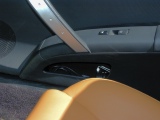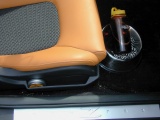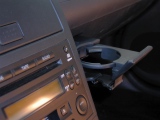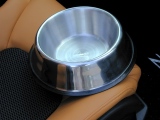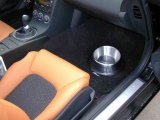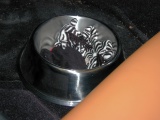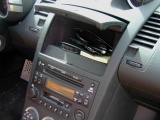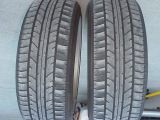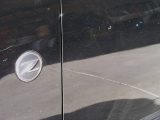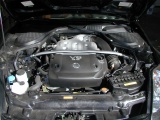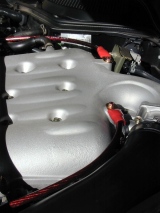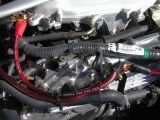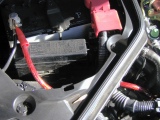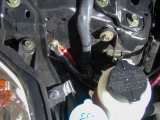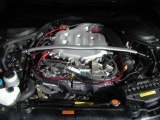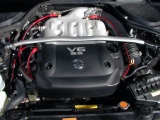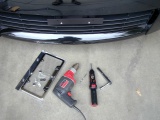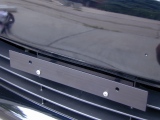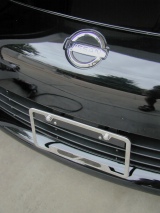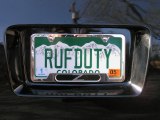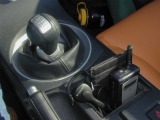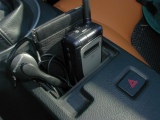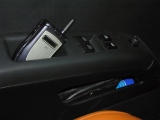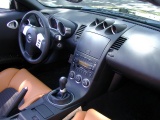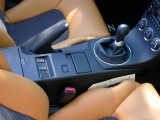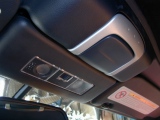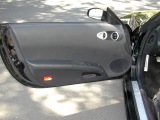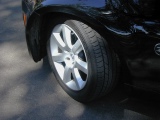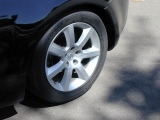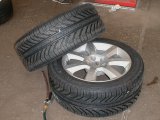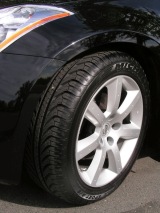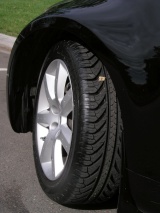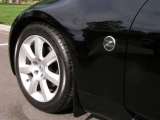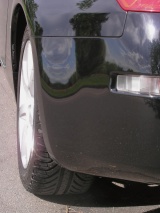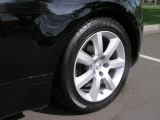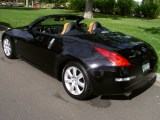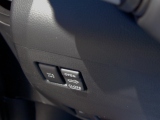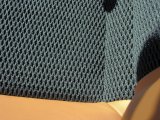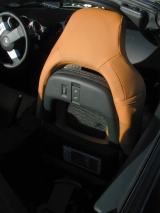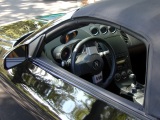
350ZR» An Unofficial
350Z Roadster Resource
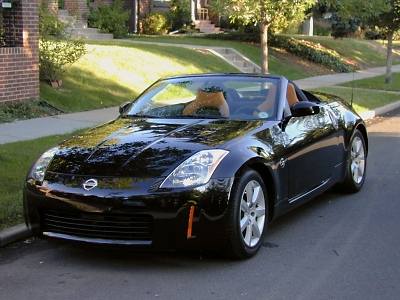
|
On 350ZR» |
"Adventure is inconvenience properly perceived." — Llewellyn Thomas
"Places to go, things to do, Porsches to pass..." — 350Z showroom banner
"Think of it as a high-performance park bench with a mechanical beauty far exceeding any external good looks." — the author
350ZR» 2004 Roadster Issues and Fixes
On this page...
Last revised on 06/04/2005 at 21 months and 15,400 miles from purchase.
Nothing's perfect*
The 2004 roadster clearly left behind some of the known imperfections of the early 2003 coupes, but it still carries forward some minor 2003 flaws and manages to add a few, most of which are common to 2004 ragtops and coupes alike.
Most of the 2004 roadster issues I'm aware of turn out to be minor annoyances or confusions, but some— like the 2003 right drift and front tire feathering problems, and the tendency for multiple manual transmission replacements in some 2003s— are potentially serious matters that may or may not have been fixed for 2004. Only time will tell at this juncture. IMO, the 350Z pros still far outweigh the cons, but it's better to know about such things up front.
What you won't find here are complaints like, "Why didn't Nissan throw in this or that expensive feature for the price?" If they threw in the kitchen sink, the 350Z would cost a lot more. Then they'd be tempted to cut back on the mechanicals. Thanks, but no thanks. The car is a bargain as is by any standard, and the motoring press seems to agree. An article in the November, 2003 Road & Track opined that the stock 350Z stands among the best sports cars ever made, and we all know the kind of cars they hobnob with. Even more telling is this recurring theme: At every car magazine with a long-term 350Z test, the staff fought daily over who got to take the 350Z.
* In the heat of his best sermon, "We're all sinners before God," Reverend Symington swept his hand slowly over the congregation and commanded in a quavering voice, "Let any man or woman among us who can claim perfection rise!" To his utter astonishment, a middle-aged man in the last pew rose. The congregation gasped. The minister leaned over the podium with a stern, piercing look. "Surely, sir, surely you don't consider yourself perfect," he sputtered. "No, no, of course not, Reverend," said the man. "I'm standing in proxy for my wife's first husband."
New or fixed For 2004?
The ^online list of the Technical Service Bulletins (TSBs) issued on the 2003-04 350Z outlines what's gone on with the 2003 models. What's been fixed for 2004 remains unclear at this early stage of the model year, but some of the early 2003 problems (e.g., power window grease streaks and malfunctions) were apparently already rectified in later 2003 units. Nissan added a subwoofer to the Bose audio system and claims to have "retuned" it, but I'm sorry to say that it still disappoints in the mid-range. Front tire feathering still plagues some 2004 Z-cars.
According to a 12/01/03 news item, ^CarWeek, "Far East Peek: Nissan makes running changes to 2004-model 350Z", 2004-model Z's got additional interior padding here and there, a new center dash compartment lid, some texture upgrades around the instruments, easier to reach seat belts, a less harsh "Euro-tuned" suspension and, on cars so equipped, dual-cylinder Brembo brakes. By all accounts, these changes first appeared on cars made in October, 2004 or later. Certainly, none of the interior changes showed up in my July, 2003 roadster.
First, the home runs
Let's give credit where credit is due: Nissan got most things right and all the really important things (the mechanicals) spectacularly right in the 2004 roadster. Before I start nitpicking, let me count some of the biggest home runs, in no particular order:
| Plus | Photo | Comments | ||||
| Unparalleled performance-to-cost and fun-to-cost ratios |
|
Z-cars got their start delivering unbeatable performance-to-cost ratios, and the 350Z is no exception. For starters, the 350Z's impressive 11:1 weight-to-power ratio is matched only by high-end sports cars costing far more and by muscle cars with far less refinement and handling prowess. | ||||
| Normally-aspirated 3.5L DOHC V-6 and 6-speed manual transmission |
|
I can't rave enough about
the way the engine and the 6-speed manual transmission work together,
but words like "effortless", "tight",
"solid", "holy moly!" and "yeeee ha!" come
to mind. You'll just have to try it to see what I mean. Peak
torque (270 ft-lb) comes at 4,800 rpm, and the engine couldn't be happier there.
The manual transmission is a joy to work. The close, well-chosen
gear ratios make it easy to bring peak torque to bear under wide range of
driving conditions.
Torque is good. |
||||
| Suspension and handling |
|
For me, Nissan struck the perfect balance between handling and ride comfort. The emphasis is clearly on performance, but the roadster handily doubles as a daily driver. Much of the credit here goes to the 350Z's exceptionally rigid chassis, which in the roadster's case was further stiffened to compensate for the lack of metal on top. The roadster took on an extra 240 lbs. over the coupe in the process but was then geared down a tad to keep quickness on par with the coupe. | ||||
| Braking |
|
The roadster's standard (non-Brembo) disc brakes are strong and sure. In fact, their one-shot 100-0 and 60-0 mph stopping distances rank among the best in the world. Fade is a non-issue on public roads — even on long, spirited mountain runs On the track, however, the brakes could use some help. | ||||
| Steering |
|
The 350Z points quickly and precisely, with a little understeer in extremis to keep things more or less under control. At the limits of adhesion, throttle steering is quite predictable. The power steering provides just the right mix of assist and feedback. Nothing about this car is out of touch with the road. | ||||
| Pedal layout and feel |
|
Some complain here, but the pedal layout works for my 11˝C dogs. I can easily heel-and-toe (work the brake and accelerator with the right foot alone) if I wear the right shoes. The clutch spring is surprisingly light for a performance car, and the engagement point is very predictable. | ||||
| Instrumentation and controls |
|
Handsome, informative and easy to read — what more do you need? The digital driving computer display makes it easy to keep an eye or your speed or gas mileage. | ||||
| Auto-dimming mirror with HomeLink transceiver |
|
With suitable storage for even a garage door opener in short supply, the mirror's X-10-compatible ^HomeLink universal transceiver turns out to be a real boon. Train it to open your RF-controlled garage door or driveway gate, control home lights, start the coffee, or turn off your daughter's music before entering the house. The RF-controlled X-10 gizmos required on the home-side are less expensive than you might think, especially on e-bay. | ||||
| Hand (cruise) controls |
|
The hand controls are the by far best I've ever encountered. Your right thumb operates the simple 3-button interface comfortably without straining the hand's grip on the wheel. Thanks to the 350Z's drive-by-wire electronic throttle control technology, the car responds to the hand controls as smoothly, stably and predictably as to the gas pedal. If your right foot is as hard to reign in as mine, try dialing in 25 mph when you enter your next school zone. Then sit back and relaaaaaax. | ||||
| Styling |
|
The roadster's looks certainly work for
me — and also apparently for the many passersby who go out of
their way to compliment it with a frequency I've never experienced with any
other car. I still get lots of comments 2 years down the line.
Positive attention is good, especially when you share a living space with teenagers. |
||||
| Exhaust music |
|
The engine's song is automotive music, pure and simple. It's silly, I know, but as USA Today's automotive editor James Healy pointed out in his glowing review, the 350Z roadster's all about sensations, and this is one of its very best. "Listening to the engine's song rising and falling as the gas and gears are worked makes the Z Roadster so entertaining that a radio seems superfluous." I couldn't agree more. | ||||
| Powered ragtop |
|
Fast, easy to operate and smooth as silk. (Just pray it never breaks.) With an 18-second up or down time, there's little risk in putting the top down in iffy weather. You can easily button up at a stoplight without holding up traffic. | ||||
| Quiet cabin air |
|
Even at speed with the
top and windows down, the cabin air is amazingly still, thanks in part to that
"Z"-bearing glass air dam behind the seats. Nissan claims to
have pumped a lot of wind tunnel time into their quest for quiet cabin air. I believe
them.
A less obvious but but no less welcome benefit of quiet cabin air is temperature control. In Denver, comfortable top-down temperatures are easily attainable year-round. |
||||
| In-dash 6-CD changer |
|
Bose sound quality is still substandard for a car in this price range, but I give the 2004 touring package's in-dash 6-CD changer an A+ for changing speed and ease of operation. |
You'll find more discussion of the pluses on the shake-down cruise and Break-out! pages.
Misses and fixes, 2004 roadster
The table below lists some of the imperfections I've personally encountered in my 2004 roadster. Also included are a few well-documented issues that I have yet to experience. Most of the problems are insignificant, and I remain enthusiastic about the car, flaws and all. I mention them here not to whine, but to help new and prospective Z owners understand and approach them as they see fit. The offered fixes are simply the ones I've chosen to pursue or consider for my own Z.
For the record, my 2004 350Z Touring Roadster came with burnt orange-trimmed ventilated seats, the standard 7-spoke 17" wheels and tires, TCS (Traction Control System) but not VDC (Vehicle Dynamic Control), aluminum kick plates, and carpeted floor and trunk mats. The standard 2004 touring package came with a number of features sold separately in the 2003 "Premium Package", including the Bose audio system and the auto-dimming mirror with the HomeLink transceiver.
Aside from a highly recommended do-it-yourself engine grounding kit, ^Hawk HPS front brake pads and some high-temperature (DOT4) brake fluid, my roadster is completely stock and will probably remain so until the CXO (X = anything you can think of) gets her new deck and landscaping.
As you read on, please keep the Llewellyn Thomas quote at the top of the page firmly in mind. Note that "OE" stands for "original equipment".
Bottom of gallery
| Issue | Photos | Description | Comments and Fixes | |||||||||||||||
| Automatic climate controls inscrutable |
|
The 3 automatic climate control knobs (bottom) come with some unexpected twists. For example, turning on the fan or pushing the recycling mode button turns on the A/C light. This common 2003 gripe is alive and well in my 2004. | On closer
inspection, this odd behavior is more a curve ball than a real problem.
Turning on
the fan does indeed light the A/C "standby" light, but the A/C
compressor kicks in only when needed. The confusing light signifies only
that the A/C is ready if called upon by the automatic climate
sensors.
Bottom line: The climate control system does an admirable job once you get past the somewhat counterintuitive user interface. Once set, it requires very little adjustment. |
|||||||||||||||
| Baked ham |
|
The ventilated seat bottoms are always a bit warm. It's generally quite tolerable, but if you suddenly notice your butt really baking, check your seat heater rocker switch — the one cleverly located aft on the center console, right about where the driver's elbow lands when holding the shift lever. | After much thought, I've come to see the seat heater switch positioning as a feature, not a bug. It's Nissan's subtle way of reconditioning us to keep our right hands on the steering wheel where they belong, and I have to say, it seems to be working, at least on the open road. Around town, it's still a nuisance that has "accessory opportunity" written all over it. A decent-looking self-adhesive hinged switch cover would sell. So would an elbow-proof switch that disables both seat heater rockers. | |||||||||||||||
| Blinkers inaudible |
|
Nissan claims that the 350Z's LED brake lights and turn signals are quicker to fire up than their incandescent forebears, but the synthesized click of the all-electronic blinkers isn't nearly loud enough— even at a standstill with the top up and the audio off. | If you depend on the loud "click-click-click" of the thermomechanical blinker switches of yesteryear to remind you to turn off your turn signal or 4-way flasher now and then, you'll need to find some other cue. Short of a quick dope-slap from your passenger (doh!), heightened awareness is only defense I can think of. | |||||||||||||||
| Brake dust! |
|
With the
factory pads, the front wheels collect brake dust like crazy, especially around town. The front wheel accumulation seen in the
top frame represents only 5 days' worth under mixed city and highway driving.
By comparison, the rear wheels stay fairly clean. The bottom frame shows a rear wheel that hadn't been cleaned in over 3 weeks and 300 miles, again with stock pads. |
The
350Z's static front/rear weight distribution is an enviable 50/50%, but
the front brakes still do the lion's share of the stopping. All other
things being equal, the front brakes would be expected to generate more
dust, but after installing a pair of highly-recommended ^Hawk
HPS front pads, the front wheels actually ran much cleaner than the
rears.
Even so, a minute or two of wheel brushing can make a substantial improvement in the car's day-to-day appearance. Like most silver-colored alloy wheels, these 17" OE wheels are painted and should be cared for accordingly, but it's safe to dry-brush the brake dust off. At first, I used the brush shown at left ($3 from the supermarket, dust pan included), but an equally cheap long-handled wheel brush from K-Mart proved easier on the back and knees with no visible marring of the wheel finish. |
|||||||||||||||
| Bose audio system— improved but still wanting | Few 2003 350Z owners have repeatable things to say about the ^Bose audio system. For 2004, Nissan/Bose added a 10" speaker they call a "subwoofer" behind the driver's seat (bottom frame), and they claim to have retuned everything. Granted, the 2004 sound quality's better, but it's still substandard, mainly for lack of a mid-range. On the positive side, the fast in-dash 6-CD is a pleasure, and with the right music, the "subwoofer" can provide a nice lumbar massage. | Avoid the
Bose option if you can, particularly if you plan to replace the audio
system anyway, but here's the rub: The auto-dimming mirror/transceiver
bundled with the Bose audio in the 2004 touring package is a very
desirable feature.
If you get stuck with a Bose system, you might try setting the bass and treble at zero or even negative levels to give the mid-range a chance. Nissan and Bose both acknowledged the poor 2003 audio performance and promised a fix for 2003 owners back in 2004. How that's played out since I have no idea, but interested owners might check with Patty Bolack of Bose customer relations at (800) 231-2673 or via ^http://www.bose.com/contact_us. |
||||||||||||||||
| Cabin noise |
|
The roadster is reasonably quiet with the top up. Wind and road noise become progressively louder as first the top and then the windows come down, but even then, I find it quite tolerable. You won't hear much of the radio or your mobile phone in that last configuration, but wind in your hair has its own rewards. |
The obvious first step is to run quieter tires.
For those times when you must DWP (drive while phoning), a headset
with an amplified earpiece helps. Whatever you do, don't turn up the audio system to drown out the road noise! The ear-damaging effects of loud sound are both insidious and additive, whether from road noise, music or both. If you find your audio uncomfortably loud when you bring the car to a stop, you're endangering your ears, period. |
|||||||||||||||
| Cargo space scarce, especially in the roadster |
|
My
wife has handbags with more capacity than the
roadster's trunk, but that's to be expected in a
mid-size roadster. After all, the top has to go somewhere. In all fairness, the
trunk holds
more than it looks if you're willing to pack in several small bags or use
the trunk as one large suitcase.
Scattered through the cabin are several storage bins and pockets, but most are small, inconveniently shaped, hard to access, or all three. The 2nd, 3rd and 4th frames show the bin in the dash and the coin and storage bins in the console. Not shown are two additional book-sized covered bins behind the driver's seat. The generous locking "glove box" behind the passenger seat (5th frame) is big enough for boxing gloves or a full-size brief case but access is awkward at best, even with no passenger. Don't overlook the "secret compartment" below the glove box floor pad. It'll hold several small or flat objects. Also provided are small pockets in both doors (6th frame) and on the outboard sides of both seats (last frame) and a map pocket at the bottom of the back of the passenger seat. |
Bottom
line: Learn to travel light and pack the trunk very efficiently.
That's simply one of the trade-offs you accept for the privilege
of open-air motoring in an 350Z. Nissan deserves some credit for opening
up spaces for storage bins wherever they could, but storage is still
scarce.
As you might imagine, there aren't many places to stow beverage containers, either. The dog bowl in the passenger footwell in the last frame is my working solution for Nalgene bottles and wide-bottomed commuter mugs. For $29 MSRP, Nissan offers an accessory seat-back organizer that looks like a good bet for 350Zs with removable headrests, but it won't work with the integrated head rests that come with the ventilated seat option. ^Case Logic makes a number of caddies of potential interest to 350Z owners strapped for storage. To my mind, the most attractive of these is a front seat caddy that mounts to and theoretically moves with the seat bottom. Some have had luck with this caddy, but I couldn't get it to move properly with the seat using the supplied mounting system and didn't bother trying to jury-rig a substitute. Target carries these and many other Case Logic offerings at prices well below those found on the Case Logic website. Packing the 350ZR for a long trip can be quite a challenge, particularly if you have to give up the other seat and footwell to a real live passenger. Fancy wheeled luggage wastes far too much precious space, so try this old small plane pilot's trick instead: Clean out the trunk and use the whole thing as your suitcase. Filling all the odd-shaped and otherwise unusable recesses with smaller items frees up a good bit of volume for larger items in the center. Stuff one of the recesses with a single large folded-up duffle for shuttling gear between car and room. |
|||||||||||||||
| Compass gone in 2004 auto-dimming mirror |
|
Contrary to some reports, the auto-dimming mirror does not include a compass in 2004. | The compass would have been nice, but it's no great loss — just don't waste your time looking for it like I did. | |||||||||||||||
Cup holder shortage |
| Face it:
The only way to get enough cup holders is to buy a mini-van. Chances are,
you're not that desperate.
With the 350Z, you get 3 holders for narrow-bottomed cups: A very fragile-looking fold-away single by the passenger's left knee (top frame), and a 2-cup insert for the center console storage bin (not shown). In place, the 2-cup insert is very hard to reach and to my mind wastes precious cabin storage space.
|
If you prefer commuter mugs or other wide-bottomed containers, you'll need to get creative, but keep in mind that the only flat surfaces of any significance in the 350Z cabin are the footwell floors. Since the driver's footwell isn't a safe place for loose objects of any kind, the passenger's footwell is your only hope. The OE cup holders won't take a commuter mug or a 1.0L ^Nalgene bottle, but a 64 oz. rubber-rimmed stainless steel dog bowl on the floor in the passenger's footwell will. The bowl stays put, contains its cargo reasonably well and stays clear of the passenger's legs and feet if tucked up against the seat. Its contents remain well within the driver's reach, but you may have to negotiate access rights with passengers who don't recognize the driver's mandate to absolute power. To stabilize loads lacking a wide flat base, I use a plastic mesh sack of glass beads from a bed and bath store. It fits the bottom of the dog bowl perfectly. Any flat round beanbag will do here— including some of those countless hoards of Beanie Babies languishing in your garage. |
|||||||||||||||
Dash storage bin doesn't always open |
|
The open dash storage bin shown here is your consolation for opting out of the navigation package. The 350Z's limited cabin storage makes the reluctant latch more a sticking point than it really deserves. | A light jab at the
button works better than a simple press; persistence and holding your
mouth just right also help. The small size and odd shape of this shallow bin limit its utility, but I'm thankful that Nissan elected to make the space available— they could have just covered it up in Zs without the navigation package. |
|||||||||||||||
| Feathered Front Tires |
|
Some 2003 and 2004 350Z owners
have experienced excessive wear (feathering) along the inside edges of
their front tires, as illustrated at top right.
If you observe uneven front tire wear, or hear excessive tire growl below 30 mph or under moderate braking, have your dealer inspect your 350Z immediately. Realignments and tire replacements for feathering are now warranted for 2 years, but why waste precious rubber? |
Since negative wheel
camber enlarges the critical inside contact patch in corners, most
track-oriented sports cars like the 350Z use it front and back. You'd
expect some uneven tire wear in any such car — especially one with the
350Z's low-end torque and cornering ability. Soft-compound OEM tires like
the 350Z's Potenzas can only aggravate the situation.
That said, the feathering seen on some 350Zs is clearly excessive. An article in the Spring, 2004 issue of SportsZ Magazine claims that a specially formed Nissan engineering task force continues to seek the cause, but they doubt a fundamental suspension flaw at this point. See the online version of the article for more details, or this PDF of Nissan's latest official technical service bulletin NTB04-043, dated 4/12/2004. You'll find much more on the feathering issue at www.NissanTireProblems.com. |
|||||||||||||||
| Fragile paint |
|
Complaints about fragile paint are frequent among 2003 and 2004 350Z owners. Color doesn't seem to matter here, but some colors (like my black) show the inevitable chips and scratches more than others. | My roadster picked up two nasty
door dings and several minor nose chips in its first 2 months. Shortly
thereafter, I found several scratches on the crease along the rear edge of
the trunk lid — probably
from my son's nylon school bag. In each case, the 350Z parted with more paint than
other cars I've known would have. Whenever I mention the fragile paint to my service rep, who's generally been quite responsive, he falls into a blank look. |
|||||||||||||||
| Grounding the engine |
|
Have you noticed a power
flat spot just off idle, or a bit of engine roughness at 4,500 rpm and up?
Beefing up the engine's grounding (earthing) pathways will eliminate these
minor but recognized 350Z quirks. But that's not all. Added benefits include more immediate throttle response at all engine speeds and, according to one dyno test*, an extra 5 bhp at 5,100 rpm and 6 ft-lbs of torque at 5,400 rpm, with lesser gains throughout the power curve. And all this for under $30 if you do it yourself! You'd be lucky to get gains like that with a cold-air intake and cat-back exhaust costing over $1,500 in parts alone. ** With that kind of bang for the buck, it's easy to see why so many experienced 350Z enthusiasts recommend grounding as the first engine modification. |
Better
grounding increases the signal-to-noise
ratio across the board for the scores of electronic sensors feeding
real-time engine information to the car's ECU (electronic control unit)
— especially for high-frequency, performance-critical inputs
like the oxygen and mass air flow sensors. Simply put, faster and better
ECU decisions translate directly into improved engine performance,
particularly in a car with drive-by-wire throttle control and
ECU-controlled variable valve timing.
In ~2.5 hours, I fabricated and installed do-it-yourself engine grounding cables using only $29 in parts and supplies and the detailed illustrated online instructions kindly provided by the folks at Z-extreme.com. (If you like, they'll sell you a set of high-quality cables ready to install.) Bottom line: I highly recommend this simple but highly gratifying modification. The claimed benefits— increased engine smoothness, responsiveness, power and torque— are real and noticeable, and the cost and effort are negligible. I used to be able to feel 6,000 rpm coming, but no more. That programmable "up shift" warning light now earns its keep. * Turbo & High-Tech Performance Magazine, July, 2003** Dyno-tested exhaust shoot-out, Sport Z Magazine, Fall, 2003
|
|||||||||||||||
| Front license plate mount |
|
Guide dimples
mark the drill points (ouch!) for the OE front plate holder. (Note the author's
reflected feet cleverly pointing at the dimples in the top frame.) If you'd rather
keep your dimples intact, catch your dealer before the prep crew installs the OE front plate holder.
The rear plate (last frame) attaches to built-in threaded inserts taking 16 mm M6 1.0 pitch metric machine screws. |
An
excellent alternative to
the OE front plate holder is Up Front Enterprises' black anodized aluminum
^Zee-Bracket
(1st and 2nd frames), which mounts via much less conspicuous holes drilled in
your grill. Be sure to carry a Philips
screw driver and a 3/8" open-end or socket wrench to remove the bracket
should you ever need to mount the front tow hook. The 3rd frame in this section shows Nissan's polished stainless steel Z-logo frame
in place on the Zee-Bracket, all of which are available at discount prices from ^Courtesy
Nissan Parts. Track warning: Hanging your plate in front of the grille will reduce radiator air flow, especially if you also install an after-market grille like the mesh unit shown in the last frame. With plate and grille in place, my roadster seriously overheated on its 1st track day, but temporarily removing the front plate fixed the problem. |
|||||||||||||||
| Mobile phone— no place to g | The
sculpted 350Z
interior offers no safe, accessible, out-of-the-way 2 x
1.75" flat spot to mount the car
holster for my smallish mobile phone. When I'm stuck DWP (driving while
phoning), the phone lives in the console recess normally inhabited by the coin receptacle.*
Even with a liner, the hole has room for the phone, a headset and a coin
purse bulging with nearly as much change as the original hard plastic
receptacle could hold. Better
yet, everything stays put.
Whatever you do, don't mount anything on or near your airbag covers! Should the airbag ever deploy, an overlying phone or holder would instantly become a potentially lethal high-speed projectile aimed directly at your head. Potential EMT report excerpt: The air bag would have saved him, but the cell phone holder ended up in his left frontal lobe. =8^( |
For details on a fairly simple way to
gussy up
the console coin receptacle recess for duty as a phone holder, see Phone Home on the Tips
& Tricks page.
<soapbox>Please try to talk hands-free whenever you're stuck DWP. The statistics on DWP are abundantly clear: As an impediment to safe driving, DWP tops smoking and eating in the car and even tops alcohol intoxication! Hands-free or otherwise, mobile phones distract from the serious business of driving. And just how does DWP differ from conversing with a passenger? For starters, a live passenger might well alert you to unnoticed hazards, missed turns, etc. Hands-free phoning also spares your brain the attendant microwave dose. Credible research results raising concerns about cell phone-related microwave exposures continue to emerge. ^Science News covered several such reports in 2004 alone. Mobile phone head-sets are cheap, convenient and ubiquitous. It's just plain common sense to use one whenever you can, in or out of the car.</soapbox> BTW, the fold-away dash cupholder makes a great headset hanger. It will also hold your phone, but small phones are likely to slip under the rail on the left side and onto the floor without added containment. * Thanks to Yobri of the 350ZMotoring.com forum for this great idea. |
||||||||||||||||
| Original equipment "summer performance" tires |
|
As of this writing, all
350Zs have all come shod with ^Bridgestone
Potenza RE040 "summer performance" tires. Perhaps Nissan
chooses
these summer gumballs to reduce its liability
exposure to driver excesses, but IMO, all-season tires would have been a
much safer bet.
Granted, the Potenzas do very well when on warm, dry pavement, but below 50°F or so, they tend to get hard and slippery. They're reputed to be so-so in the rain and impossible in the snow, but I've done no real testing under such conditions. The Potenzas are also fairly noisy, both on the highway and in the curves. In short, the Potenzas are ripe for replacement, but any alternative befitting the 350Z will be expensive, and used tires are hard to sell for true value, even on ebay. If only the 350Z packagers followed the lead of their G35 Sport Coupe counterparts, who offer all-season tires as an option. Here in Denver, I'd have taken that option in a heartbeat. |
Many 350Z owners report marked improvements
in both ride comfort and road noise after replacing the OE tires.
I seized the opportunity to switch to M+S-rated ^Michelin Pilot Sport A/S (all-season) radials all around when a nail ruined my right rear Potenza at ~5,500 miles. ^Tire Rack reports excellent to superb consumer ratings for the Pilot Sport A/S in all performance categories, and I couldn't agree more. They ride and handle beautifully and quietly, wet or dry. Two track days have shown them to be at least as sticky as the Potenzas on warm, dry pavement — and with a lot less groaning in the tight hairpins. (No, I haven't seen signs of feathering.) Short of heroic measures, I've been unable to break them loose on wet roads, even at near-freezing temperatures. Nor has there been any noticeable hydroplaning when punching through huge puddles at highway speeds during Denver downpours. As of 2004, few other high-performance all-season tires came in sizes suitable for the 350Z's standard 17" wheels. Based on detailed tire specs posted by ^Tire Rack, the Michelin sizes most closely matching the diameters of the 350Z's standard 225-50/17 front and 235-50/17 rear Potenzas were 235-45/17 and 245-45/17, respectively. These sizes fit my roadster perfectly, as you can see in the photos at left. Z owners with 18" or larger wheels will find a wide array of good Potenza alternatives out there, but I don't have details to share. |
|||||||||||||||
| Ragtop pinholes? |
Sorry, no photo
|
Early-2004 roadsters can develop pinhole leaks in their ragtops — apparently from repeated chaffing against the rear metal strut. Oddly, the holes usually develop on the passenger side. The potential for leaks is apparently limited to roadsters (like mine) manufactured in June and July, 2003. Nissan apparently made substantial changes to the top's design and materials after that. | My July, 2003 top
remained water-tight for about 9 months. When a pinhole appeared in the
usual location, my Nissan dealer replaced the top under warranty without a
squawk. To inspect your ragtop for pinholes, get inside the car with the top up on a sunny day and look for light coming through the cloth — particularly around the bends in the rear crossbar. Confirm any pinholes with a flashlight, then take your roadster in for a top replacement (cloth plus frame) right away. Nissan has been replacing leaking tops without hesitation, but they apparently won't replace tops with partial-thickness rub marks alone. Acknowledgment: Thanks to my old friend Les Novikoff for sharing his leaking top experience. |
|||||||||||||||
| Right drift? |
Sorry, no photo |
No 2004 owners have complained of it on 350ZMotoring.com as of November, 2003, but some 2003 350Zs drifted excessively to the right due to suspension or subframe malalignments covered under warranty. | According to NTB03-046 dated April 25, 2003, a 350Z with excessive right drift will effect a complete lane change to the right in less than 7 seconds at 60 mph on a straight and level roadway in the absence of steering inputs. (Please conduct this test on a multi-lane road safely out of traffic.) Mine passes, but if your Z fails, or if you hear excessive tire growl under moderate braking below 30 MPH, or if you observe excessive uneven front tire wear, have your dealer inspect your Z immediately. Realignments and tire replacements for drift are apparently only 1-year warranty items. | |||||||||||||||
| VDC, TCS or both? |
|
The 350Z manual describes Nissan's optional Traction Control System (TCS) and Vehicle Dynamic Control (VDC) package separately but fails to make it clear that TCS is a subset of VDC. If you find a "TCS" switch on the dash by your left knee, you have only the TCS component of VDC. If you find a "VDC" switch, you have the full VDC package, including TCS. Either way, there's only one switch. | In a
letter appearing in the Winter, 2003 issue of Sport Z
Magazine, Robert Scholer, a 350Z engineer with Nissan North
America, wrote that VDC is a coupe-only option, at least through 2004. Why it's not
offered on roadsters, he didn't say. By design, VDC/TCS is on by default at startup. The switch is there only to disable VDC/TCS when you don't want it — and you definitely don't want either one engaged on your Z club's track day. Legitimate racers unhappy with the default may want to look into a ^VDC auto-off kit. The rest of us are unlikely to have the time or presence of mind to turn VDC/TCS back on when we really need them. |
|||||||||||||||
| "Ventilated" seat bottoms always warm |
|
The seat back netting covers a gaping hole (upper frame) that readily passes fresh air to the occupant's back. No problem there, but the seat bottom netting covers solid-looking padding (lower frame) with no clear means of ventilation. My "ventilated" seat bottoms are always a bit warm — even when I manage to avoid turning on the seat heater with my elbow. | Are you
old enough to remember those early fishnet-style "thermal"
long-johns? As with all thermal fabrics since, they worked by trapping
small pockets of dead air (with its negligible thermal conductivity) between
the skin and the next layer out. Fishnets worked exceedingly well as long
as the air in those pockets could be cut off from exchange, and that's
precisely what happens in an occupied "ventilated" seat bottom.
The result — a toasty butt no matter what.
That said, I'd probably buy the ventilated seats again. |
|||||||||||||||
| Visibility limited with the the top up |
|
With roadsters of any make, top-up visibility
is limited at best, and the 350Z ragtop is no exception. A look over either
shoulder reveals little of the outside world, no matter how much you crane
your neck.
Winging out the side mirrors to minimize overlap with the center rearview mirror is always a good idea, even if it takes a little getting used to. That certainly helped the 350ZR's top-up visibility, but not enough for my comfort. |
We managed to cover
the roadster's gaping top-up blind spots nicely with two articulated windshield-mounted convex "autobahn mirrors" from ^Griot's
Garage, one on each side. The outside mirrors don't have much
room for stick-ons, and these provide a lot more coverage anyway.
(I tried both approaches.) As an added benefit, the articulated
mirrors can be pushed out of the way when you're at speed on a twisty road
and need to see as far as possible around the next turn.
The plastic ball joints in my driver-side mirror lost their hold after about 7 months of use. I haven't yet tried the spray adhesive the instructions recommend for keeping the joints in place. |
Top of Gallery
Some of the issues listed here are also discussed on the shake-down cruise page.


